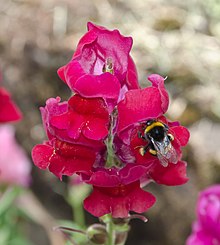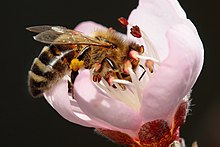pollination

In the case of sexual reproduction of the seed plants, pollination is the transfer of the pollen with the sperm cells contained in it to the ovule (in the case of the naked samers ) or on the stigma of the carpels (in the case of the bedecktsamern ). Each pollen grain then forms a pollen tube that grows towards the egg cell and releases the sperm cells there. By fusing one of the sperm cells with the egg cell ( fertilization ), the zygote is created , from which theEmbryo emerges, which is then spread with the semen .
The pollen is transmitted either by the wind or by animals visiting flowers, usually insects . The very resistant pollen grains can be found in deposits up to 270 million years old, and their free distribution by the wind still outweighs that by animal pollinators.
procedure
More naked

At the bottom left male flower with pollen sacs (yellow), at the top female flowers (pink), in the middle cones that have arisen from a female flower
The pollen sacs tear open in the naked samers, and the pollen grains are usually transferred as pollen dust by the wind ( wind flowering ) to the exposed (bare - hence the name naked) ovules. A drop of liquid emerges through an opening in the ovule, the micropyle , to which the pollen grains adhere. The pollen grains are sucked into the pollen chamber as they dry out. The micropyle is then closed by cell growths in the surrounding integument. The pollen does not germinate immediately, but after the pollen has dormant, a few days to a year later. The two sperm cells are then brought to the egg cell with the pollen tube. One sperm cell degenerates, the other fuses with the egg cell to form a zygote.
More covered

1. flower base
2. sepals
3. petals
4. stamens with pollen sacs
5. pistil with thickened stigma
In the case of the Bedecktsamern, the pollen grains are transferred to the stigma of the ovary by the wind, by animals or rarely by water (in the case of aquatic plants). In addition to the vegetative or pollen tube cell, the pollen grain usually contains one, and in some plants two sperm cells. The pollen grain germinates by absorbing moisture, and the pollen tube grows to the ovule in the ovary, where it usually penetrates through the micropyle. If the pollen grain only contained one sperm cell, it divides after germination so that there are always two sperm cells. In the ovule is the embryo sac , which usually consists of seven cells, including the egg cell and the central cell. Now double fertilization takes place (which only occurs in the bedecktsamern): One of the sperm cells fertilizes the egg cell, the other the central cell. While the embryo emerges from the fertilized egg cell (zygote), the fertilized central cell develops into a nutrient tissue, the endosperm .
Cross-pollination and self-pollination
As a rule, the pollen comes from a different flower than the one that is being pollinated. This is known as cross- pollination . In plants with multiple flowers, the pollen can come from a flower on the same plant, which is known as neighbor pollination or geitonogamy . Of self-pollination is when pollination occurs within a flower, the organs of both sexes has (or hermaphroditic hermaphroditism ).
Self-pollination or neighbor pollination usually does not lead to self-pollination because, as a result of self-incompatibility, only foreign pollen is pollinated.
Wind pollination and animal pollination
Wind flowering or anemophilia is the evolutionarily original form of pollination. It requires large amounts of pollen and easy access to the ovule or stigma. The pollen grains are small and light, have a more or less smooth surface and are in the form of fine, dry dust.
In the case of animal pollination ( zoophilia ), the plant must draw the pollinator's attention to its flowers, achieve the uptake of the pollen and its release to the stigma, and through "rewards" ensure that the pollinator performs these tasks regularly. It attracts the pollinator's attention primarily through optical and chemical stimuli: color and fragrance. The nutrient-rich pollen, which is offered in excess in such cases, or nectar serve as rewards .
The flower colors visible to humans are mainly based on water-soluble dyes in the vacuoles and fat-soluble dyes in the chromoplasts . The vacuoles are mainly anthocyanins or betalaines , which mostly appear red, pink, purple or blue. Orange and yellow carotenoids are found in the chromoplasts . The color of the plastids depends on which pigments are formed, while the pH value is decisive in the aqueous environment of the vacuoles : The organic acids such as malic acid and citric acid that are always present in vegetable juices cause a rather red color, while over the roots absorbed basic minerals produce a rather blue color. Pollinating insects such as honeybees and bumblebees hardly react to red, but very much to the ultraviolet which is imperceptible to humans and which is also based on pigments in the vacuoles.
See also
- Pollination performance
- Agamospermia (formation of seeds without sexual processes)
literature
- Joachim W. Kadereit, Christian Körner, Benedikt Kost, Uwe Sonnewald: Strasburger - Textbook of Plant Sciences . Springer, Berlin / Heidelberg 2014, ISBN 978-3-642-54435-4 , pp. 165 ff ., doi : 10.1007 / 978-3-642-54435-4 .
Web links
- Birgit Nordt: Pollination - flowers and bees and ... - a million year old love story. Botanical Garden Berlin (PDF; 5.52 MB).
